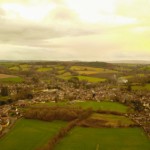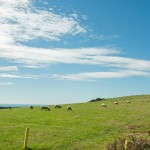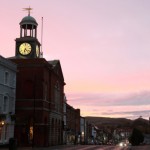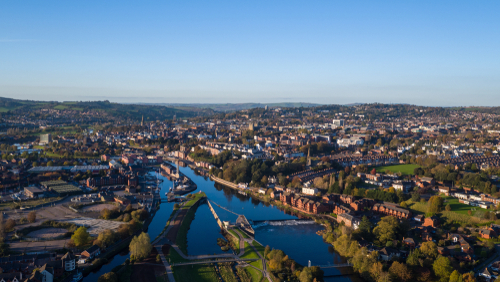
A quick guide to Exeter
Exeter is an ancient city in the county of Devon in the southwest of England. It lies on the River Exe, some 36 miles (58 km) northeast of Plymouth and 65 miles (105 km) southwest of Bristol. It’s the county town of Devon and home to the University of Exeter. At the last UK national census in 2011, the population of Exeter was recorded as 117,773.
A Fleeting History
There have been some small archaeological finds around Exeter to suggest the area was settled as early as 250 BC, although it may well have been much earlier. Britain’s invading Romans arrived in Devon around 55 AD, and meeting little resistance from the indigenous Celts, they soon established the fort of Isca Dumnoiorum at the site of present-day Exeter. The fort, built as the southwest terminus of the Fosse Way, is thought to have housed the 5,000 strong Second Augustan Legion, led by Vespasian, who was later to become a Roman Emperor. It wasn’t too long before a civilian Roman-Britannic settlement began to develop around the fort.
The fortress was largely abandoned by Rome circa 75 AD which allowed its grounds to be utilised by the neighbouring civilian population. Towards the end of the 2nd century, the settlement was fortified when a wall was built around the 37-hectare site. By the time the Romans finally deserted Britain around 410 AD the settlement at Exeter had already been largely abandoned. Life for the indigenous population soon pretty much returned to that of pre-Roman times, with most returning to the countryside to eke out an existence.
Life in Exeter barely changed for the best part of next three centuries, which was until England’s new invaders, the Saxons, reached Devon in the late 7th century. In 680 AD, the Saxons decided to build a monastery inside the walls of the old Roman town. The Saxon word for ‘fortress’ or ‘fortified town’ was “ceaster”, while “exe” meant ‘water’ or ‘river’. Thus, the name of the settlement of the ‘fort by the river’ was anglicised to ‘Escanceaster’.
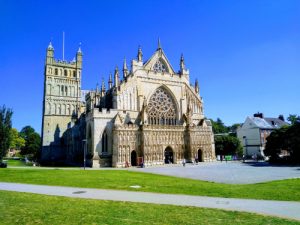
Exeter Cathedral was first constructed in 1050
In 876, Exeter was attacked and captured by the invading Vikings, but they were driven out by Alfred the Great in the following summer. Alfred then declared that Exeter would become a ‘burgh’ – a stronghold, that would provide refuge to both civilians and the military, against marauding invaders. This elevated status gave Exeter more kudos, leading to busier local markets, the foundation of its own ‘mint’, and even rudimentary town planning, as well an increase in population.
By 928, King Athelstan was ruling over Exeter and further strengthened its defences by the restoration of the old city walls. In 1001, the Viking Danes besieged the town but were unable to penetrate its defences. They eventually retreated in the knowledge that substantial English forces were advancing towards Exeter. However, two years later the Danes attacked the city again, only this time luck was on their side. The reeve, an early mayor type figure, for unknown reasons, turned traitor, letting the rampaging Danes into the city through a gate in its defence walls. The town ended up almost completely devastated but its resilient residents were quick to rebuild.
In 1050, Leofric, Bishop of Devon, decided he wanted to move his seat from Crediton to Exeter, which set the building of Exeter cathedral in motion. By this time, Exeter’s population was somewhere around 2,500, a fair-sized town by the standards of the time.
In 1068, two years after the Norman conquest of England, Exeter staged a rebellion against the rule of William I. The revolt was perhaps influenced by the fact, that the mother of the slain King Harold, Gytha Thorkelsdóttir, was living in Exeter at the time. However, William promptly mobilised his army, forcing the city to lock down, under siege. After 18 days, William accepted an honourable surrender by the city, swearing on oath to end the matter without wilful damage or bloodshed. King William was true to his word but quickly arranged for the building of Rougemont (Red Hill) Castle to strengthen his control over the area. Manors under the ownership of Saxon landlords were quickly transferred to that of Norman barons. And, in 1072, following on the death of Bishop Leofric, William appointed his own cleric Osbern FitzOsbern, to the vacant position of the Bishop of Devon.
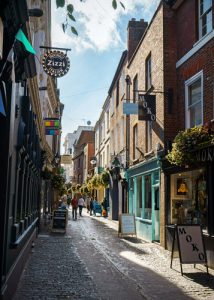
The 13th century ‘Gandy Street’ is considered by some as an inspiration for Harry Potter. (Photo Max 555/Shutterstock)
In 1114, the Normans decided to rebuilt Exeter Cathedral. However, by ecclesiastical standards, it had a relatively short life as it demolished in 1260, before being rebuilt once again.
As early as the 13th century the wool trade was already well established in Exeter, with tanning being another important business of the city. Exeter soon became an important port, mainly exporting wool and importing wine. From 1213, there was a market being held in Exeter every week, and by 1281, there were three weekly markets. There were also seven annual fairs in the city, the earliest dating back to 1130. However, at the end of the 13th century, Isabella, Countess of Devon, had a weir built across the River Exe, 3 miles south of Exeter. With ships could no longer being able to navigate the Exe estuary, Exeter’s maritime trade had to be shifted to Topsham.
By 1500, Exeter had a population of around 8,000, a large and important town of the time. The main industries were still the manufacture of wool and leather. In 1549, Henry VIII’s controversial ‘Dissolution of the Monasteries’ Act, eventually led to a rebellion in Exeter. The protesters laid siege but were unable to capture the town and fled when a royal army was dispatched to deal with the situation. In 1566, a canal was dug around the weir on the Exe so the town was once again able to flourish as a port.
In 1642, at the outbreak of the English Civil War, Exeter gave its support parliament. However, in June 1643, a royalist army laid siege to the city, forcing a surrender within 3 months. They held the city for more than 3 years, but in early 1646, parliamentary forces recaptured Exeter.
During the 18th century, life in Exeter began to markedly improve, at least for the well-to-do. Travel writer and social commentator of the time, Celia Fiennes visited the city in the early 1700s. She remarked on the “vast trade” and “incredible quantity” in Exeter, documenting that “it turns the most money in a week of anything in England”. By 1707, Exeter had its first newspaper and by 1760, oil-lamp street lighting. In 1769, the city’s first bank opened as well as new Assembly Rooms. In the same year, the city’s North Gate was demolished to facilitate the flow of traffic. In 1774, the County Courts were built, which was followed by the opening of the Devon and Exeter hospital, four years later. Also, in 1778, a new Exe Bridge was constructed, and the practise of building footways along the edges of main streets became the norm. In 1784, the city’s East Gate was flattened to make way for progress.
In 1801, at the time of the first national census in 1801, Exeter had a population of some 20,000, making it a large and important town of the time. However, due to the city’s relative remoteness from a ready supply of coal, the latter part of the industrial revolution was to largely pass Exeter by. While the 19th century saw Exeter’s population grow in numbers, reaching almost 50,000 in 1901, it declined in relative terms. In 1801, Exeter had been the 6th most populace place in England, however by 1860, it had fallen to 60th position. Also, by this time its traditional chief industries of wool manufacture and tanning were in serious decline. Exeter importance was now viewed nationally, as little more than a market town.
In 1844, the train travel arrived in the city to Paddington, London, when the Great Western Railway (GWR) opened a station at St Davids on its western outskirts. The South Devon Railway Company extended the line westwards to Plymouth, opening their own smaller station at St Thomas. In 1860, a more central station was opened at Queen Street by the London and South Western Railway when it provided an alternative route to London.

In 2018 Exeter Airport handled almost 1 million passengers. (Photo – Peter Turner/Shutterstock)
In 1882, the first horse-drawn trams were introduced to Exeter. The three lines emanated from the city’s East Gate, terminating at St David’s station, Livery Dole and Mount Pleasant. In 1905 electric trams replaced the now-dated horse-drawn ones. By the 1920s, trams had become somewhat problematic, since they were viewed as slow, a major cause of traffic congestion, and expensive to maintain, which was especially true for track renewal work. The local authority made a decision to replace the tram service with double-decker buses. Consequently, on 19 August 1931, the last public service tram made its final journey through the streets of Exeter.
Exeter Airport was officially opened on 31st May 1937, operating from a temporary “tented” terminal, before the permanent buildings were complete. However, the first commercial charter flight into Exeter landed on 12th May 1937, which also happened to be Coronation Day of George VI. From then onwards there was a steady growth in air services to the Channel Islands. Today, as well as still flying to the Channel Islands, there are direct flights to 19 European destinations and Toronto in Canada. In 2018, Exeter was found to be the 23rd busiest airport in the UK, handling almost 1 million passengers during the year.
During World War 2, between April 1941 and April 1943, there were a total of 18 bombing raids carried out on Exeter by the German Luftwaffe. The city was deliberately targeted in the wake of the RAF’s bombardment of the medieval Lübeck. The bombardment resulted in much of the city centre being flattened, with some 1,500 houses being destroyed and a further 2,700 seriously damaged. Six churches were also destroyed or badly-ravaged and the cathedral was damaged. Poland’s 307 Squadron, nicknamed the ‘Lwów Eagle Owls’ were stationed at Exeter Airport and tasked with protecting the city against the much greater numbers and superior firepower of the Luftwaffe. The city of Lwów shares the same motto as that of Exeter – ‘Semper Fidelis’ (Always faithful).
The modern Era
In the 1950s, much of the bomb-damaged city centre was rebuilt. Corresponding with the general thinking of the time, little attempt was made to preserve partially damaged buildings, meaning the city lost a number of its landmark historical structures in the name of development. In October and December of 1960, Exeter was subject to two incidents of serious flooding, which led to the construction of new flood defences for the city. The work began in 1965 and took 12 years to complete, at a cost of £8 million (around £185 million today.
Following the 1950s refurbishment of the town centre, the modern era saw substantial growth of Exeter. In 1955, Exeter University was founded, 1967 saw Northcott Theatre built, with the Maritime Museum opening in 1969. The Guildhall Shopping Centre was completed in 1977, with the construction of the Harlequins Shopping Centre following in 1986. In 2004, the Met Office moved to Exeter, and 2007 saw the opening of the massive Princesshay Shopping Centre. Despite much development, about 70 per cent of the 2000-year-old, 3 km long old city wall still remains intact.

Polish Flag is raised annually at the Guildhall
Since 2012, a Polish flag is raised over the city’s Guildhall on 15 November in honour of 307 Squadron, the day is now known as ‘307 Squadron Day’ in the city. On 15 November 2017, a plaque in memory of the squadron was unveiled in the St James Chapel of Exeter Cathedral.
In 2104, a£32 million improvement scheme to the city’s flood defences was approved. While Phase 1 is complete, the delayed Phase 2 of the project started in 2016 and is still ongoing (2020).
Today, most of Exeter’s workforce is employed in the service industry, such as tourism, education and public administration, etc.
Getting there!
By Road
Located 4 miles from Junction 29 of the M5 from the North, the A30/A303 from the East and the A38 from the West, there is an easy route into Exeter from any direction.
By Train
Exeter has two main train stations, both located within easy walking distance to the city centre. Exeter St David’s is the main hub, providing links to major destinations across the UK. Exeter Central is the closest station to the High Street and connects the city centre with the outlying areas. Great Western Railway, South West Trains, Cross Country and Virgin all operate frequent services to and from Exeter.
By Bus
National Express operates a bus service from London Victoria direct to Exeter city centre. There are 11 buses per day and the journey takes around 5 hours. They also operate frequent services between Exeter and many major destinations across the country.
By Air
Exeter International Airport is just 6 miles out of Exeter and can be easily reached by car or bus via the A30. There are daily flights to London and other major national airports, as well as some international flights.
Getting around!
Stagecoach South West operate frequent services across Exeter and its outlying areas. There are also three ‘park and ride’ schemes in operation from Honiton Road, Sowton and Matford. All normally operate 6 days a week, with Honiton Road also operating on Sundays.
Did you know?
• Exeter’s Guildhall is the oldest civic building in Britain with some parts of the structure dating back to 1160.
• Exeter was the last place in the UK where a woman was tried and put to death for being a witch.
• There are seven other places in the world called Exeter, all in North America.
• The alternative name of Exeter Cathedral is the Cathedral of St Peter.
• Exeter’s Royal Clarence Hotel has claims on being the oldest hotel in the country, dating back to the 1500s.
Famous People

JK Rowling*
A few famous people who were born or have connections to Exeter are:
- JK Rowling – world-renowned author (especially for the Harry Potter series), film & TV producer, and screenwriter, attended Exeter University between 1982 – 1986.
- Chris Martin – singer, songwriter, musician and record producer is the lead singer and co-founder of the rock band Coldplay. He was born in Exeter in 1977.
- Tommy Cooper (1921 – 1984) – a greatly-loved comedian and magician who famously wore a red fez. He was brought up in Exeter from the age of three.
- William Temple (1881 – 1944) was a much respected Anglican priest, who served as Archbishop of Canterbury between 1942–1944. He was born and spent his early life in Exeter.
(*Photo – Everett Collection/Shutterstock)
Exeter City FC
Exeter City Football Club is a professional football team that plays in England’s League Division Two, the fourth tier of English football. The club was founded in 1904, playing at St James Park, where they still play to this day. In 1920, they became an inaugural member of the English Football League’s Third Division. Nicknamed the “Grecians”, the origin of their moniker is still subject to much debate. The club is owned by the club’s supporters, through the Exeter City Supporters’ Trust.
Things to see and do!
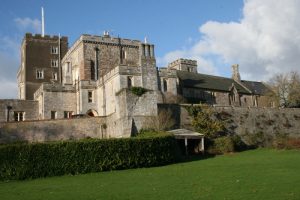
The impressive 600-year-old Powderham Castle
• Exeter Racecourse – the South West’s most prestigious racecourse sits at the top of Haldon Hill, just outside Exeter. There are fantastic panoramic views across Dartmoor.
• Powderham Castle – 8 miles from Exeter, is a great day out for all, offering a great guided tour of the impressive 600-year-old structure
• Haldon Forest Park – consists of 3,500 acres of woodland and is just a 15-minute drive from Exeter. Open 364 days a year, it’s ideal for those who love the great outdoors, as there are miles of trails for walkers, runners, cyclists and horse riders.
• Crealy Theme Park & Resort – is a great family day out! The multi-award-winning theme park is located just minutes from junction 30 of the M5 near Exeter. It has more than 60 indoor and outdoor rides and attractions.
• Exeter Canal & River Fishing – coarse fishing is available on the canal between the Canal Office and Double Locks. A rod licence that can be obtained from the Environment Agency rod licence is required.
• Exe Estuary Trail – is a newly constructed 26 mile (mostly flat) combined cycleway and footway which runs along the entire length of the Exe Estuary. Linking Exmouth, Exeter and Dawlish, there are fantastic views along the way.
• Quay Climbing Centre – the South West’s largest indoor climbing wall, it’s located in the heart of quayside in the former Electricity Building.
• Exeter Quayside – the striking historic quayside is regarded as one of the best-preserved Georgian harbours in Europe. It’s popular with locals and visitors alike, housing a great number of pubs, restaurants, bars, cafes, etc.
• Aerosaurus Balloons – provide hot air balloon flights across the South West of England, crossing over some of the most spectacular countryside in the UK.
• Woodbury Park Golf Course – a must for all golfers! A world-class course set in the heart of the fantastic Devon countryside.
• City to Coast Walk – the 8-mile walk through the Exe Valley starts on the Quayside and ends at Starcross, situated on the west bank of the estuary. A bus or train can be taken back to Exeter.
Where to stay?
There is a good choice of accommodation in Exeter close to the city centre. A rough guide to average prices for one night for 2 adults sharing is:
Guesthouse/B & B/Lodge: £70 – £100
Hotel: £100 – £150
Holiday Let (2 – 4 people): £150 – £250
